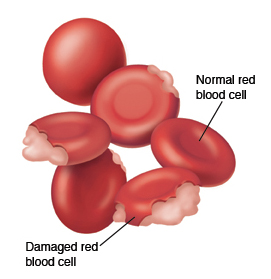When Your Child Has Hemolytic Anemia
Hemolytic anemia occurs when the body doesn't have enough healthy red blood cells (RBCs). This is because the cells are destroyed too early. The body also doesn't make new RBCs fast enough to replace the ones that are destroyed. There are many types of hemolytic anemia. Your child's healthcare provider will tell you more about the type your child has. The provider will discuss treatment options with you.
 |
| With hemolytic anemia, the red blood cells break down and are destroyed before their normal lifespan. |
What are the red blood cells?
Blood cells are made in the bone marrow. The bone marrow is the soft, spongy part inside bones. There are three types of blood cells. The RBCs are one type. RBCs are important because they contain hemoglobin. Hemoglobin is a protein that allows RBCs to carry oxygen all over the body. Normally, each RBC lives in the body for about 4 months. New RBCs are made daily to replace the ones that die naturally or that are lost through injury or illness.
What are causes of hemolytic anemia?
The causes of hemolytic anemia vary depending on the type your child has. Possible causes include certain infections and medicines. Hemolytic anemia can also occur because of some inherited conditions or autoimmune disorders. These cause the body's immune system to destroy its own RBCs.
What are the symptoms of hemolytic anemia?
Symptoms can range from mild to severe. Some children have no symptoms at all. If symptoms are present, they can include:
-
Pale skin
-
Extreme tiredness (fatigue)
-
Shortness of breath
-
Trouble doing normal amounts of physical activity (exercise intolerance)
-
Rapid heartbeat
-
Dizziness or fainting
-
Yellowing of the eyes, skin, or mouth, along with dark, tea-colored urine (jaundice)
-
Pain in the upper belly (abdomen) due to a problem with the gallbladder, liver, or spleen
How is hemolytic anemia diagnosed?
Your child will likely see a pediatric hematologist for diagnosis and treatment. This is a healthcare provider who specializes in blood disorders (hematology). The provider will examine your child and ask about their symptoms, medicines, diet, and family and health history. Tests are also done. Most of the tests are done by taking a blood sample from a vein in the arm or from a finger or heel. Tests may include:
-
Complete blood count (CBC). This measures the amounts of types of cells in the blood.
-
Blood smear. This checks the sizes and shapes of the blood cells. A drop of blood is examined under a microscope. A stain is used to make the blood cells easier to see.
-
Coombs test. This checks for certain antibodies (proteins). These may be causing the body to have an abnormal reaction to the blood cells.
-
Reticulocyte count. This measures the amount of new RBCs being made by the bone marrow.
-
Ultrasound. This takes a picture of the gallbladder, liver, and spleen. Gallstones or an enlarged liver or spleen can be signs of a blood disorder.
How is hemolytic anemia treated?
Treatment for hemolytic anemia varies depending on the cause and severity of symptoms. The goal is to decrease or stop the RBCs from being destroyed and to restore the amount of RBCs to normal. Possible treatments include:
-
Diet and medicine changes. Certain foods and medicines may need to be limited or avoided. If this is needed, you will be given instructions.
-
Blood transfusions. These are done to give your child more blood. They are needed if the blood cell count falls too low.
-
Medicines. The body's immune system may be causing problems with the production of the RBCs. Medicines may be given to suppress the immune system.
-
Plasmapheresis. This procedure removes the plasma from the blood. It replaces it with plasma from a healthy donor. This may be needed if antibodies in the plasma are affecting the RBCs.
-
Surgery to remove the spleen (splenectomy). The spleen stores blood and helps remove old RBCs from the body. This surgery is done less often. But removing the spleen may help treat certain types of hemolytic anemia.
-
Bone marrow transplant. In rare cases, this treatment is done if the body can't make enough healthy blood cells. It replaces diseased bone marrow cells with healthy cells from a matched donor.
What are the long-term concerns?
-
Depending on the type and cause of hemolytic anemia, some children recover completely after treatment.
-
For other children, hemolytic anemia may be a lifelong condition. They may need regular visits with the healthcare provider for routine tests and to help manage symptoms. Work closely with your child's provider to learn how to help your child. Be sure to discuss how to help your child prevent possible problems. This includes things such as physical activity, diet, and ways to reduce the risk of bleeding or infections. It's important to know if your child's hemolytic anemia is the type that is inherited and may run in your family. That's because other family members may be affected. It may also be useful to know for family planning.
Online Medical Reviewer:
Adam Levy MD
Online Medical Reviewer:
Dan Brennan MD
Online Medical Reviewer:
Jessica Gotwals RN BSN MPH
Date Last Reviewed:
12/1/2022
© 2000-2025 The StayWell Company, LLC. All rights reserved. This information is not intended as a substitute for professional medical care. Always follow your healthcare professional's instructions.